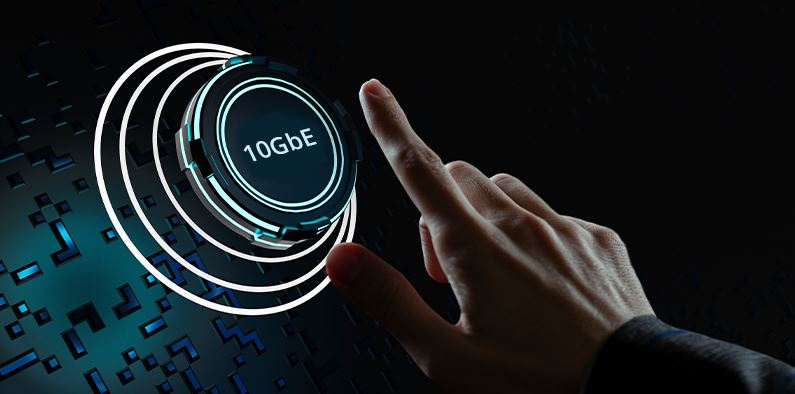
10 Gigabit Copper Cable Standard Introduction
The development of copper cables is closely related to the development of Ethernet technology. Copper cables have always played an important role in the network connection market, and their vitality is still strong. In order to meet the higher transmission rate requirements of future data centers and network backbones, IEEE 802. The 3an standard was promulgated in 2006 and defines the 10GBase-T interface standard. At the same time, the development of cloud technology and virtual technology requires higher performance cabling systems. In February 2008, TIA and ISO successively released the CAT 6A/Class Ea cabling standard. At that time, the standard number of TIA was ANSI/TIA-568-B. 2-10, which is the 10th revision of the 568B standard. Subsequently, ANSI/TIA 568C, promulgated in early 2009, established the CAT 6A wiring system more clearly and completely. Previously, ISO 11801 has also established the Class Ea standard, so TIA has a more profound influence on China.
During the development of this standard, there have also been some different voices in the market, such as CAT 6E, low-energy 10GBase-T interfaces, and short-distance 10GBase-T applications. Confidence, allowing design and installation freedom, must use standard CAT 6A to support standard 10GBase-T. The following describes how CAT 6A is defined in ANSI/TIA-568-C. CAT 6A is referred to as Enhanced Category 6 in the standard. CAT 6E is the name for a certain historical stage and has been obsolete.
The strongest 10 Gigabit copper cable market is the data center, so the data center standard has also entered the CAT 6A era in terms of cabling. As shown in Figure 1, it can be seen that both the ISO data center standard and the TIA data center standard have included the CAT 6A/Class Ea standard in the recommended level. ANSI/TIA-942 updated the standard in 2012 and introduced ANSI/TIA-568-C.
10 Gigabit Ethernet Applications
There are many 10 Gigabit Ethernet interfaces, which are generally referred to as 10 GE, and the most promising one is 10GBase-T. To support 10GBase-T applications, a CAT 6A copper cable must be deployed. Wiring products have been used in mature applications. For example, most domestic and foreign manufacturers are able to manufacture CAT 6A cables, and some manufacturers also have a good ability to manufacture CAT 6A connectors.
The rapid development of CAT 6A depends on the extensive use of 10GBase-T interface equipment. Figure 3 shows the development forecast of DELL and Intel for 10GBase-T interfaces. After 2012, the sales of 10GBase-T interfaces will grow rapidly.
With the decrease in power consumption and cost, the advantages of 10GBase-T are becoming more and more obvious in terms of cost, support distance, compatibility, and ease of use. At the same time, as an infrastructure, it must be forward-looking, and choosing CAT 6A now is to lay a solid foundation for future development. 10 Gigabit copper cable has indeed entered a period of rapid growth as expected in previous years, which is generally optimistic.
Shielded and Unshielded Options
Like CAT 5e and CAT 6, CAT 6A still has shielded and unshielded options and international standards do not define the selection basis for shielded and unshielded products. Shielded and unshielded are simply how they are manufactured to achieve performance.
From the manufacturer’s point of view, shielded CAT 6A production is easier, while non-shielded requires higher requirements in R&D, production, and quality control. But unshielded is more convenient for users and installers and remains popular in the market. Shielded wiring has higher requirements for construction and grounding, but this is not just a CAT 6A problem. Shielded CAT 6 also requires good shielding. In fact, for the wiring system, the biggest challenge of the shielding system is not from the manufacturing and design, and installation, but the test of the shielding layer itself.
1) Strict construction in accordance with the manufacturer’s installation instructions.
2) Verify the continuity of the shield with a wiring certification test instrument.
3) Strictly perform the grounding test.
By completing these three tasks, it can be assumed that the shielding system is available and qualified. From the perspective of alien crosstalk, the sales volume of shielded cables in 10 Gigabit copper cables may increase. There is little difference between shielded and unshielded from the perspective of design and testing. Construction is the biggest difference between the two, but shielding The white paper can be used as a good construction reference, so there is not much repetition in the 10 Gigabit copper white paper.
There is much debate in the market that the outer diameter of the CAT 6A unshielded cable is thicker, so it will occupy more pipe grooves during construction. Many manufacturers also produce thinner unshielded CAT 6A with good alien crosstalk resistance.
Also read about
How To Choose Best Invoicing Software for Small Business In 2022

